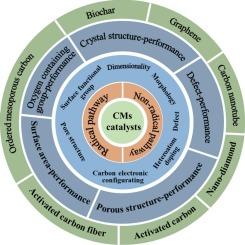过硫酸盐基深度氧化法去除水体污染物的无金属碳材料研究进展与展望
IF 9.2
2区 工程技术
Q1 ENERGY & FUELS
引用次数: 0
摘要
目前,过硫酸盐基高级氧化工艺(PS-AOPs)因其在消除折射污染物方面具有广阔的潜力而迅速发展。无金属碳材料(CMs)具有比表面积高、表面官能团丰富、结构可调节性好、生物相容性好、环境友好、制备方便等优点,是一种新型的高活性催化剂,在清洁能源生产、环境修复、医药等领域得到了广泛应用。这些显著的物理化学特性保证了cms基材料在PS-AOPs中的催化作用。本文从类别、催化过程机理、提高CMs催化活性的裁剪策略以及CMs的微观结构-性能关系等方面对PS-AOPs中基于CMs的材料进行了综述。首先,我们讨论了CMs的不同类别、特点和应用。其次,介绍了cms型催化剂催化过硫酸盐活化的可能机理(包括自由基途径、非自由基途径以及自由基与非自由基联合途径)。此外,为了进一步提高cms催化剂的催化活性和评价其环境影响,总结并提出了一些有前景的裁剪策略和环境影响评价方法。最后,提出了基于cms的材料在环境修复中面临的挑战和未来的发展前景。综上所述,这将有助于揭示CMs在PS-AOPs中的迷雾,为CMs/PS-AOPs系统在废水污染净化中的进一步发展提供参考,并为CMs的应用带来一些多学科的启发。本文章由计算机程序翻译,如有差异,请以英文原文为准。

Advances and prospects of metal-free carbon materials for persulfate-based advanced oxidation processes in aquatic pollutant removal
Nowadays, persulfate-based advanced oxidation processes (PS-AOPs) are flourishing promptly owing to their promising potential in eliminating refractor contaminants. As the novel and high-activity catalysts, metal-free carbon materials (CMs) are extensively used in clean energy production, environment remediation, medicine, as well as other fields because of their higher specific area, abundant surface functional groups, excellent structural adjustability, good biocompatibility, environmentally friendly, and facile fabrication. These remarkable physicochemical characteristics may guarantee CMs-based materials to be hopeful catalysis in PS-AOPs. In this work, we make a comprehensive review of CMs-based materials in PS-AOPs from different aspects, including categories, catalytic process mechanism, and tailoring strategy for enhancing catalytic activity of CMs as well as the microstructure-performance relationship of the CMs. First of all, we discuss the different categories, characteristic, and application of CMs. Secondly, the possible catalytic mechanism of persulfate activation (including radical pathway, non-radical pathway, and the combined radical and non-radical pathway) by CMs-based catalysts were introduced. In addition, in order to further enhance their catalytic activity and assess environmental impact of CMs-based catalysts, some promising tailoring strategy and environmental impact assessment methods were summarized and put forward accordingly. Finally, challenges as well as future prospects of CMs-based materials in environment remediation were mentioned. Overall, this account will certainly help to reveal the mist of CMs in PS-AOPs and give some reference to facilitate the further development of the CMs/PS-AOPs systems in wastewater pollution purification, and bring out some multidisciplinary afflatus for CMs applications.
求助全文
通过发布文献求助,成功后即可免费获取论文全文。
去求助
来源期刊

Sustainable Materials and Technologies
Energy-Renewable Energy, Sustainability and the Environment
CiteScore
13.40
自引率
4.20%
发文量
158
审稿时长
45 days
期刊介绍:
Sustainable Materials and Technologies (SM&T), an international, cross-disciplinary, fully open access journal published by Elsevier, focuses on original full-length research articles and reviews. It covers applied or fundamental science of nano-, micro-, meso-, and macro-scale aspects of materials and technologies for sustainable development. SM&T gives special attention to contributions that bridge the knowledge gap between materials and system designs.
 求助内容:
求助内容: 应助结果提醒方式:
应助结果提醒方式:


